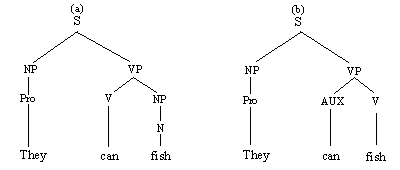5.4.4 Tree diagrams
A tree diagram is a formal representation of sentence structure with
syntactic categories provided ( It is also referred to as a phrase maker
or a constituent structure tree). In 5.3, we analyze the ambiguous phrase
green grapes and pears by way of tree diagrams. But in those
tree diagrams there are no syntactic categories. A tree diagram without
syntactic categories fails to reveal ambiguous structures in some cases.
For example, the sentence They can fish is ambiguous. The ambiguity
can be shown clearly if the syntactic category of each constituent is
marked. Consider the two tree diagrams:

These up-side-down “trees” disclose three aspects of speakers' syntactic knowledge:
1. The linear structure of the sentence (i.e. the order of words in
the sentences);
2. The hierarchical structure of the sentence (what category is above
what other category and what are its immediate constituents);
3. The lexical category of each word (what class of words each lexical
item at the bottom belongs to).
In transformational generative grammar, tree diagrams and phrase structure
rules are closely related. Phrase structure trees are believed to be generated
by phrase structure rules. There should be no discrepancies between the
two. In 5.4.3 we generalized four tentative phrase structure rules:
(i) S → NP VP

(iii) VP → (Aux) V (NP) (PP)
(iv) PP → P NP
These rules can generate a great number of sentences. Rule (i) generates:

Rules (ii) can generate five different NP structures, as the rule can
be expanded into:
NP → N
NP → Adj N
NP → Det N
NP → Det Adj N
NP → Pro
Rule (iii) can generate eight different VP structures, as its constituents are:
VP → V
VP → Aux V
VP → V NP
VP → V PP
VP → V NP PP
VP → Aux V NP
VP → Aux V PP
VP → Aux V NP PP
As rule (iv) specifies that PP is composed of P and NP, the structure of PP can be as various as NP structures. Now we can see that phrase structure rules can generate an enormous number of tree diagrams even without lexical items.
Tree diagrams correspond to phrase structure rules
in specifying syntactic categories. The categories that occur to the left
of the arrow in a phrase structure rule are phrasal categories. They do
not appear at the bottom of the tree. They label the node
point or branching of the tree. The categories that never occur on the
left side of the arrow are lexical categories, which are labels of class
of words right above the words at the bottom of the tree.